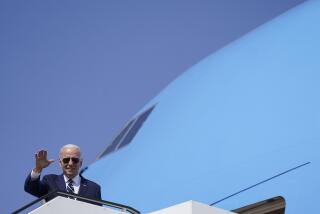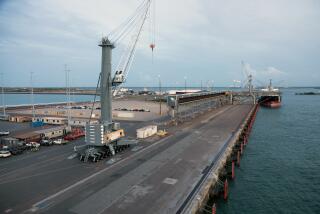A WORLD REPORT SPECIAL EDITION ON THE PACIFIC RIM : THE SOUTH RIM : Interview : Aligning Australia With ‘East Asian Hemisphere’
- Share via
A ustralian Foreign Minister Gareth Evans, like Prime Minister Paul Keating a strong proponent of close political and trade relations with Asia Pacific nations, took the policy a step further recently, saying Australia should have a specific identity as part of the “East Asian Hemisphere.” Evans discussed the government’s position at his Canberra offices with Times correspondent Charles P. Wallace.
Wallace: After so long being considered a Western country, why does Australia feel the need to be closer to the Asian region, especially now that you are mentioning East Asia?
Evans: This is where we live. This is where we have to guarantee our security; this is where we are best placed to maximize our prosperity. For most of our existence we’ve been the odd man out in the region, not taken very seriously. The facts of our geography follow on to our Anglo-Saxon heritage, reliant on great powers far away to protect us when the chips are down--first Britain until the Second World War, the United States thereafter. Those days essentially have passed us by. We still value and take very seriously the alliance relationship with the United States, but know perfectly well (that) like any other country we have to maximize our own security protection. We cannot depend upon others to do it for us.
There is also an economic imperative. We came into the ‘80s realizing that the “lucky country” wasn’t going to go on generating all that much luck. We had to start making some on our own. The agriculture benefits that kept us going through most of the century . . . ran out as a sustainer of our economy with the emergence of common agriculture policy of the European Community. It was then replaced with the coal trains and iron-ore trains.
By the early ‘80s, we came to the realization that if we were to go on maintaining an increasing standard of living, we just had to get smart and play the same high-tech manufacturing, sophisticated service game all the other smarter countries had been doing. As we came to that realization, that also happened to coincide through the ‘80s with the huge surge of growth in our region. It’s almost a cliche now, but the tyranny of distance has become the benefit of proximity.
*
Q. Are you trying to make yourselves part of a region or are you thinking of Australia as an Asian country?
A. In the past, we have tended to retreat into the more comfortable terminology of the Asia Pacific. We have been uncomfortable, and others in the region have been uncomfortable, with any description of us as an Asian country.
What I was groping for was some new way of emphasizing the significance of the Asian connection without going so far as to make an implausible claim that we were in fact an East Asian nation. We came up with the concept of “East Asia Hemisphere” based on the same geometrical notions as the American Hemisphere or Western Hemisphere, two continents culturally different in all sorts of ways, geographically spread over a pretty big slice of globe but nonetheless bound together by their geography and also by a lot of other points of connection. It seemed to me that was really the best way of describing our relationship with this region.
Just as Mexico can very comfortably describe itself simultaneously as a North American country in the context of NAFTA (North American Free Trade Agreement), an Asia Pacific country in terms of APEC (Asia Pacific Economic Cooperation forum), and also a Latin American country, an American Hemisphere country, so too can we very comfortably think of ourselves as simultaneously an Asia Pacific country--I want to continue to emphasize the primacy of that institutional framework--and also a South Pacific country, but also very plausibly and credibly an East Asian Hemisphere country.
*
Q. In this new concept, will Indonesia be a closer ally of yours than America?
A: I wouldn’t put it in those terms. There is only one boots-and-all alliance relationship and that’s with the United States. We’re covering a whole range of reciprocal support, logistics, intelligence sharing. It is a very intimate relationship and a very important one. It’s more a matter of saying when you are sitting right next door to the world’s fourth-largest country, the world’s largest Muslim country, one that has an enormous capacity to determine our country’s future, it makes sense to pay a great deal of attention to that relationship and to build a cooperative security relationship that is closer than we’ve looked for in the past.
The Asian Pacific entity and the institutional structures within it, I think, are the main game to all the countries in the region. In economic terms, every other country is bound with the United States. In security terms, everybody in practice acknowledges the necessity of keeping the United States engaged and maintaining its relationship with Japan because if it starts to crumble or weaken, it will create real trouble.
*
Q. While your government has been talking about the need for joint Asian security, in a recent defense white paper it indicated that if there was a threat to Australia’s security, it’s from the same countries that surround it and that Australians should continue to spend a large sum of money to defend it. Isn’t that a contradiction?
A. It’s just making the obvious geographical point that any threat to Australia must come from or through the north. It’s not going to come from the penguins. I don’t think it’s going to come from New Zealand. There are an awful lot of countries to the north and there are all sorts of contingencies that can conceivably arise in the distant future.
A threat is a function of capability plus intention. There isn’t a shred of an intention that we can see, but there’s plenty of capability. Prudent defense policy for any country is one that has regard to that capability and structures a defense force accordingly.
In the Kissingeresque sense of realpolitik , real world security has always depended on there being balances around, and major imbalances created the potential of instability. That’s true of the region as a whole.
*
Q. Is there an intentional policy to make Australia more Asian through immigration?
A. Not really. It’s just an inevitable consequence of a non-discriminatory policy in conjunction with current demand-and-supply realities. A key part of the program has always been humanitarian. Just as we took a lot of refugees after the Second World War from Europe, post-1975 we’re taking significant numbers from Indochina and Vietnam, and that in turn leads to family reunion and so on, and it has its own snowball effect.
We’re doing very well out of Asia in terms of people meeting the requirements of the Australian economy. The size of the Asian population is about 4.5% and is expected to be up to 7% to 8% by 2010 and 10% by 2020. That’s pretty significant. Add to that the large number of people physically around due to tourism and a huge numbers of students; the feel of the place has changed. That makes Asians more comfortable here and (is) helping to make us more comfortable in our larger environment. Culture change works in all sorts of strange ways.
*
Q. Did the government take the lead in pursuing integration with Asia because business leaders were slow in getting off the mark to develop ties there?
A. Up until the late ‘80s, it was the slowest job in the country persuading business to develop an export culture and in particular an Asian export investment culture. For years and years it seemed like a very uphill task. As the domestic policy changed, it forced them to look offshore. But the environment changed. You’re seeing huge acceptance now by business of its Asian destiny. We are just pouring more and more effort into harnessing and mobilizing small and medium enterprises.
*
Q. In shifting your emphasis, some critics have said the Australian government is putting business before its democratic values, softening its criticism of countries that violate human rights. Has there been a change?
A. There has been some adjustment in the “how” but not in the “what” we do. If you are in the business of operating in the neighborhood with a lot of entrenched cultural perspectives that are resistant to what we claim are universal values, not Western values, then it is important to work (in) a way that has a chance of being productive.
When you’re here right next door to it, and actually trying to influence progress for the better, then you try to do what is most influential. I don’t think any country in the region would regard us as wimping out in terms of the way we raise human rights issues with absolute persistence.
More to Read
Sign up for Essential California
The most important California stories and recommendations in your inbox every morning.
You may occasionally receive promotional content from the Los Angeles Times.










